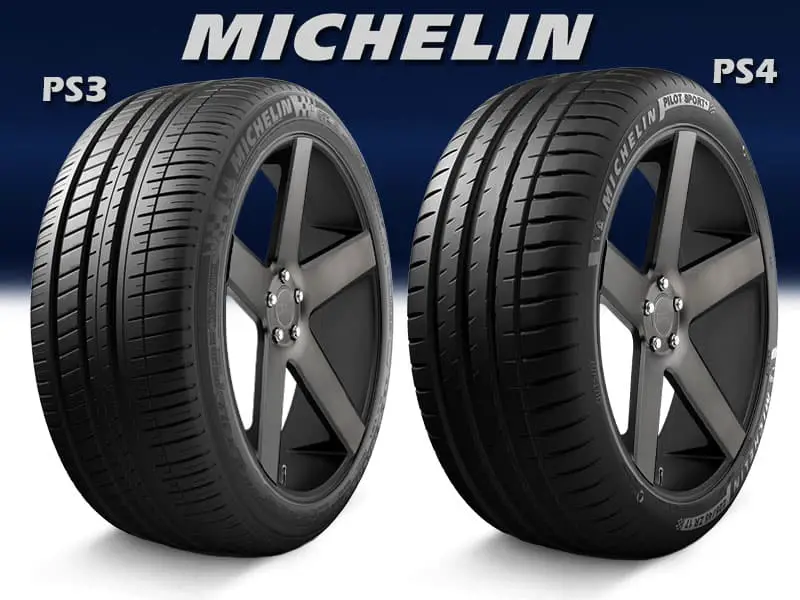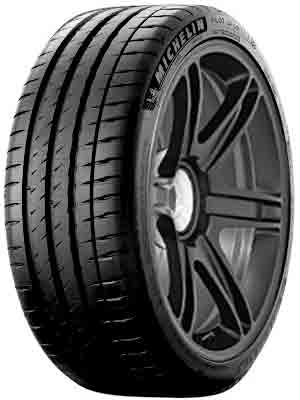Sport 4 is a max performance summer tire while Sport 3 is an ultra-high performance summer tire. The sport 4 is made for drivers looking for the best performance in all sorts of conditions without worrying about treadwear.
In contrast, Sport 3 belongs to the scaled-down version of the summer tire line i.e., ultra-high performance category. These tires are designed for moderate performance in all conditions but allow longer tread life.

Table of Contents
Comparing Michelin Pilot Sport 4 with 3
Michelin Pilot Sport 4

Michelin Pilot Sport 3

Sport 4 has an asymmetrical five-pitch tread design with four narrow circumferential grooves creating the five tread columns, two of which are shoulder while rest of three are ribs. This tire has no tread blocks column and no tie bars as well. Two circumferential grooves are widest and the third one is relatively narrower compared to the first two whereas the fourth one is the narrowest of all. All of the grooves have the same tread depth of 9.5/32”. Lateral grooves cut the shoulders into separate blocks, creating large shoulder blocks. One of the ribs has no siping while the central one has inclined sipes penetrating from the opposite direction of the sipeless rib. The remaining rib has small sipes entering from the alternating direction, with no sipe parallel to one another. Its shoulders have no sipes engraved on them.
Sport 3 also has an asymmetrical five-pitch tread design with four wide grooves, from which three are equally wider while the fourth one is as narrow as a line. The fourth groove dissects the shoulder into two, creating a rib. Each groove has a depth of 9.5/32”. There are two ribs and one tread blocks column available in this tire. The shoulder blocks are separated by lateral grooves, resulting in a comparatively lower shoulder block length than its counterpart. The shoulder that is divided by the fourth narrowest groove has lateral grooves extending up to the nearest rib, passing through the fourth groove. This rib has horizontal sipes and so do both shoulders. The central rib has the same alternating sipe design as that was found in one of the ribs of Sport 4. The final tread blocks column is formed by the dissection of deeper sipes, resulting in parallelogram-shaped blocks with no additional siping.
Grip Comparison
Sport 4 due to its three ribs has a higher contact patch, therefore, allowing greater grip on dry roads and decreasing the braking distance of this tire. Hence, this tire performs well on dry surfaces. Similarly, on wet roads, its efficient siping allow this tire to perform better with a lower wet braking distance.
There are two ribs present in the Sport 3 tire due to which it has a relatively lower contact patch. A lower contact patch decreases the grip of this tire, therefore, resulting in a less capable tire in terms of gripping. The wet braking distance of this tire is also higher due to its less efficient sipe design. This causes Sport 3 to lose in the competition of wet gripping as well.
Handling Comparison
The higher shoulder block length of the Sport 4 tire allows it to steer well in all sorts of conditions. The higher pitch length ensures a higher grip with the road, therefore, provides good steering control. In wet conditions its lateral grooves, expel the water readily, allowing this tire to maintain its grip on wet roads while cornering. Hence, we can conclude that this tire provides higher handling averages on both dry and wet roads.
The lower shoulder block length of the Sport 3 doesn’t allow it to grip the road well, resulting in the loss of speed while turning. It also lacks in wet handling even with shoulder sipes because of its unoptimized shoulder design, resulting in an inefficient lateral grooving pattern compared with its competitor. Both its dry and wet average handling speeds are lower than its peer.
Comparison of Hydroplaning Resistance
Since the grooves of Sport 4 are narrower with an equal depth as the grooves of other tire, therefore, it loses the competition of hydroplaning resistance since it provides a narrow space for the wiping of water. Its floating speed is lesser than its competitor.
Sport 3 has wider groves with the same depth as that of its counterpart, allowing larger volume for the passing of water, thus, resulting in a higher hydroplaning resistance tire with a higher float speed.
Comparison of Rolling Resistance
Sport 4 has a higher contact patch, leading to higher friction between the tread and the road. So, its rolling resistance is higher. A lot of fuel will be consumed in overcoming this friction, decreasing its fuel efficiency.
Due to the lower contact patch, the rolling resistance of the tire is also lower. Since lesser friction is caused between the tread and the road, this decreases its hysteresis loss, thus, resulting in a fuel-efficient tire.
Noise and Comfort Comparison
Sport 4 is a loud tire on-road but less noisy in comparison with the other tire. Its narrow but deeper grooves allow a large number of air particles to get trapped inside its grooves, producing noise. Whereas its subjective comfort is higher due to its extraordinary performance. The tire on the other hand struggles on providing a smooth ride over an uneven path due to the inability of its comparatively narrower grooves to absorb the shocks, making it unreliable in such circumstances.
Sport 3 is a noisier tire, owing to its wider and deeper grooves which can trap a higher number of air particles that strike back and forth with its grooves walls to produce a louder noise. Its noise is recorded at higher decibels than its counterpart. Similarly, it lacks performance capability, therefore, its subjective comfort is much lower. However, it performs well on bumpy roads due to its wider grooves acting as a suspension and dampening the impacts of shocks while traveling over an uneven road.
Durability and Treadwear Differences
Sport 4 has a higher rolling resistance which increases the treadwear of the tire. It is built with a softer rubber compound, providing superior performance but at a cost of lower treadwear resistance. Its tread wears quickly allowing the tire to cover only a limited number of miles.
Sport 3 has a lower contact patch; therefore, its rolling resistance is lower which results in a lower treadwear. The tread of this tire is made up of harder rubber, increasing its treadwear resistance. This allows Sport 3 to be a highly durable tire. High durability along with lesser wear of its tread ensures the longevity of this tire.
Price Differences
Max performance tiers are generally costlier than ultra-high performance tires due to their superior performance in all fields. That’s why the Sport 4 tire is more priced than the Sport 3 tire. Sport 3 tire provides good performance with higher mileage.
Quick Summary
- Sport 4 is a max performance tire while Sport 3 is an ultra-high performance tire.
- Both the dry and wet traction of Sport 4 is better.
- Hydroplaning resistance of the Sport 3 tire is higher.
- Sport 3 rolls with a lower resistance on the road.
- Sport 4 has lower durability and mileage in comparison
- Sport 4 is quieter with better subjective comfort but uncomfortable on bumpy roads.
- Sport 4 is a higher-priced tire.


